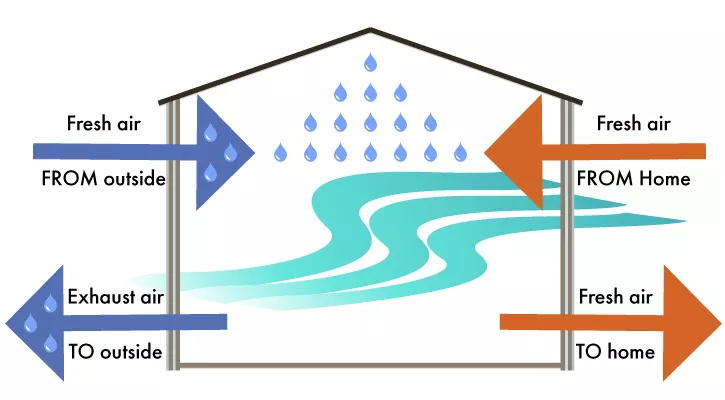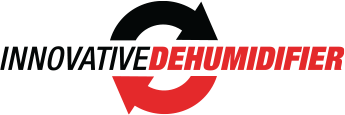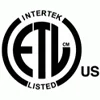
Energy Recovery Ventilators provide a direct route for fresh air to bring moisture indoors
Fresh air is essential for healthy people and healthy buildings. A ventilation system brings fresh air indoors and improves airflow. There are benefits to introducing fresh air inside with an energy recovery ventilation (ERV) system such as eliminating allergens, helping reduce heating and cooling costs, and improving indoor air quality (IAQ). Although, it should be made clear that ERV systems are not a reliable source to remove moisture; an ERV system is not a dehumidifier and actually guarantees that a dehumidification system will be necessary.
How an ERV works and its impact on humidity
Energy Recovery Ventilators (ERV) are designed to draw fresh outdoor air into the HVAC system, taking stress off heating and cooling equipment. These fresh air intake systems capture preconditioned air before it is exhausted outdoors, and transfer energy to incoming outdoor air; depending on season either hot or cold air will be transferred from stale indoor air to incoming fresh air. Allowing outside air a direct route inside is like having a window open, when outside humidity is higher than the indoor humidity, moisture moves inside, increasing the humidity in your home.
ERV systems transfer heat and water vapor through incoming and outgoing airstreams. Water vapor will move from the more humid air stream to the less humid air stream, returning the moisture from where it originated, so all the water added to the air from cooking and cleaning stays trapped inside. Imagine an apartment with the thermostat set at 70 degrees with an indoor relative humidity (RH) maintained around 55%. Does an ERV remove and control the humidity in the home without having to adjust the thermostat temperature? No, in reality, indoor humidity will rise. When outdoor humidity is 90%, even if an ERV system could reduce incoming moisture by 20% it would still significantly increase the indoor relative humidity. Joseph Lstiburek’s article Relative Humidity states “interior relative humidity should be maintained so that a 70 percent relative humidity at a building surface is avoided in order to control mold growth and should never rise above 60 percent in any event.”1
ERVS transfer heat and water vapor through incoming and outgoing airstreams. Water vapor will move from the more humid air stream to the less humid air stream, trapping moisture generated inside.
ERV’s do not remove additional moisture
An ERV will raise indoor humidity if outside relative humidity is higher since the exchange of water vapor between the two air streams is not equal.
ERVs are not designed to remove moisture and dehumidify; they do not include settings to maintain and control relative humidity or even include drainage for collected condensate. Since the exchange of water vapor between the two airstreams is not equal, an ERV will raise indoor humidity. Similar to how some heat is lost between air streams, only a fraction of water vapor is removed from incoming air, so incoming air is more humid than the air removed.
During the summer and hotter seasons when the outdoor air is more humid than indoor air, an ERV can’t remove enough moisture to keep indoor humidity below 60%. If the ERV is pulling in air over 85% RH, even a reduction in RH allows unwanted moisture to come inside. Think about it, a hole in the wall is an open invitation for moisture to seep in. In the winter, moisture generated indoors will not be exhausted outside, but is cycled through supply air, preventing moisture from escaping.

WINTER
ERVs transfer (cold-dry exterior and warm-moist interior air) heat and humidity to supply air; indoor moisture is cycled through supply air, increasing indoor humidity.

SUMMER
ERVs are unable to remove excess moisture from fresh outdoor air that replaces stale indoor air; moisture generated indoors is not removed from air with ventilation.
The Solution: Combine an ERV with a Dehumidifier
Installing an ERV air exchanger is a great way to ventilate your home and intake fresh air but they are not capable of providing adequate moisture control. To ventilate and dehumidify at the same time you will need supplemental dehumidification. ERV systems are only able to filter and transfer energy (hot/cold) to incoming fresh air, but are not capable of condensing and collecting excess moisture. If you plan to use an ERV system, include an independent and tankless dehumidification system that can automatically manage and maintain healthy indoor humidity levels. A tankless IW-25-5 dehumidifier system can easily be set to the desired relative humidity to remove excess moisture.
The IW-25-5 IN/ON Wall Dehumidifier pulls 33 pints of moisture from the air in 1,500 square feet, the average amount generated by a family of four daily. According to Kathleen Parrot, Ph.D., Professor of Housing, Virginia Tech, “to control mold growth in our homes, we must control excess moisture and water!”2 Distinctly engineered for the multifamily industry, the hands-free IW-25-5 dehumidifier includes a tamper-proof front cover that conceals digital controls, limiting access and ensuring automatic moisture control. Maintaining indoor humidity will protect your property for years to come, keeping your family and tenants healthy and happy.

Did you Know?
Managing Indoor Humidity Will make your Property More Comfortable
Sources:
1. Joseph Lstiburek, Relative Humidity, April 2002, Building Science Corporation, accessed October 2021 <https://d1wqtxts1xzle7.cloudfront.net/44521363/RR-0203_Relative_Humidity-with-cover-page-v2.pdf?Expires=1635521203&Signature=al202v~WZOr7erg3CLibE45~eoDv34FjNpHfc6kjRM7Q0hJSdejQP9Fscbk8XjCxWnF~LQiZCbZJLUtDH1qhe5VkDBmIXBPUItYyROZzKGjxp7JF~EtDHPIAWM2XWsEJohn8Ne8xWisKbXpjCzXSFOtfdnW3RDrRZIcQSG~KnbxMmR001Umz7X-uE7C3Yjs8ssgMLF~O9Woc0Gu5-OridWM0wPFSw8xTtawrDsJwxqSH65kleqFtoX2KCBPLEaKJ-Hlu5rWPOUkywYsquqdqzGNvtceFYIBQR33nTUI2IQ1mn2E8TzLUDG696dU3H5VlnfWRFrIUXPLsSb-R9znLVg__&Key-Pair-Id=APKAJLOHF5GGSLRBV4ZA>
2. Virginia Polytechnic Institute and State University; Kathleen Parrott, Ph.D. 2009, Virginia Cooperative Extension, accessed October 11, 2021 <https://vtechworks.lib.vt.edu/bitstream/handle/10919/50219/2901-7020.pdf?sequence=1>


